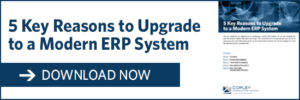Even if you’re convinced of upgrading to a modern ERP system, you’re still one big hurdle away from getting started: convincing your C Suite and Board Members that it’s the right move. And their first question will be, “What’s the TCO?” (Total Cost of Ownership). Essentially, that’s every single cost related to the implementation and operation of a modern ERP system, as well as the maintenance over its entire life cycle. Be prepared to answer that question, but more importantly, be prepared to prove that by investing in a modern ERP, the Return on Investment (ROI) will be thousandfold.
First, honesty is the best policy. Be frank about actual and potential hidden costs, and that means your ERP licenser needs to be frank with you about the same. There are five cost areas, both up front and hidden, that you need your licenser to give to you:
Up-Front and Hidden Costs of Purchasing or Updating a Modern ERP:
- Software license or subscription fee: Just like buying a car, the software license is your sticker price and will probably be the heftiest one. For on premises systems, this cost includes an upfront fee and then an annual support/maintenance fee. For cloud-based systems, your “sticker price” is the subscription fee to access the cloud solution for all your users. Many companies today choose the cloud, as this monthly fee for users is considered an operating expense versus a capital expense, which significantly impacts your TCO/ROI calculations. The cloud subscription also removes on-premises style hardware and database costs you would have to consider.
- Implementation: This cost, perhaps the heftiest if you choose to personalize or customize the solutions, includes installing hardware on-premises and configuring the software that your upgraded ERP system needs to ensure it runs at optimal performance. If you upgrade to a modern cloud-based system with most industry best practices and processes built in, much of the customization should go away, and the configuration should be quicker, again reducing your TCO. Finally, you need to add the cost of data migration and testing. Because this part of upgrading your ERP can be quite involved, it’s a good idea to work with an experienced ERP Partner to minimize implementation costs.
- Training: Although this cost could be lumped in with the implementation of your ERP or the subscription fee, it varies from business to business and is often miscalculated. You’re best to leave this as a separate line-item. Knowing how quickly your employees can learn the new processes is essential to nailing down a more accurate number—some employees will need only primary training, but others may need additional, or secondary. You should build in cross-functional training if you genuinely want your ERP to be an enterprise-wide one. Otherwise, why upgrade? Finally, you need to realize that a successful implementation can take up to one year; some employees will leave, replacements will come on board, and training will begin anew with them. Have a good guesstimate of what your company’s employee turnover rate is and build that into this line-item. You cannot underestimate the organizational change management that needs to take place during an ERP project, which leads us to the fourth cost.
- Ongoing personnel support and maintenance: Although this cost will not be as hefty as the “down payment” of your ERP system, you will need to include salary and benefits for a support team to manage the process, work through any bug fixes or updates, provide technical support, work with employees resistant to change, and continue adding improvements to your upgraded system. Also, expect that hardware well, wears out, and you’ll need to continue investing in the infrastructure (on-premises servers or computers, mobile devices, and kiosks for cloud solutions) to ensure your ERP system keeps on delivering the benefits you want.1
- Operating: To take advantage of your modern ERP, you’ll need to configure optimal internet connectivity. If you are upgrading to a cloud-based ERP, you won’t have to figure in added utilities costs, such as lighting and cooling for a dedicated server room, but you will if you are upgrading an on-premises system. You will also need to figure in storage space for servers for an on-premises deployment.
Once you’ve delivered the tough news, you can then focus on the good: explaining the tangible and intangible advantages for upgrading to a modern ERP. The goal of your ERP system is to improve business productivity and agility, but you need to be more specific to convince your C Suite and your Board. They will want you to thoroughly answer one question: “What’s our ROI?” The ROI (Return on Investment) “is always the key metric for business decision makers,2” but can you calculate the ROI of a modern ERP implementation in dollars? The answer is yes, but the ROI calculation can be different for each industry or company. An ERP partner can help you determine what business processes and metrics will be most impacted by a modern ERP at your company to help you calculate your company’s ROI.
The tangible benefits you can calculate:
- An increase in revenue
- A reduction in inventory level, including raw material, work in progress and finished goods, through improved planning and control
- A reduction in materials costs and wastes through improved purchasing and accounts payable practices
- A reduction in labor costs, including overtime for production workers such as technicians and skilled workers, through better allocation
- A reduction in shortages, interruption, and rework through better scheduling of critical equipment and subcontracting operations
- A reduction in after-sales services cost
The intangible benefits that are immeasurable:
- A breakdown of business silos and increased collaboration and transparency company-wide
- An increase in inventory record accuracy and a reduction in errors
- An improvement in customer service, on-time shipments, and a shorter floor-to-door cycle.
- A streamlining of standardized procedures.
- A shorter sales-to-cash cycle and improved accounting procedures.
- An improvement in legal and regulatory compliance
Once you receive the green light to upgrade your current on-premises system or purchase a modern ERP, you will then begin to see your hard work pay off. Your modern ERP system will touch and connect every operational corner of your business, and they will foster a data-driven mindset company-wide2. Sit back and relax (momentarily), knowing that this investment will give your organization the flexibility to support growth and adapt to any changes your business undergoes through the years.
1. ERP Focus
2. Improve business productivity and agility with modern ERP
3. Return on Investment (ROI) in ERP Project
Gold-Standard ERP Implementation Services

Copley Consulting Group has been an Infor Gold Channel Partner for nearly 30 years. We offer the expertise and project management resources to make your enterprise’s Infor CloudSuite™ or Infor SyteLine implementation seamless. We’ve helped more than 250 small- to mid-size manufacturers transform their operations worldwide.
CONTACT US TO
Request A Personalized Demo
Ready to see what Infor CloudSuite™ and QC can do for your organization? We’d be happy to schedule a no-obligation, functional demo of how it works. Share a little about yourself and we’ll be in touch.

